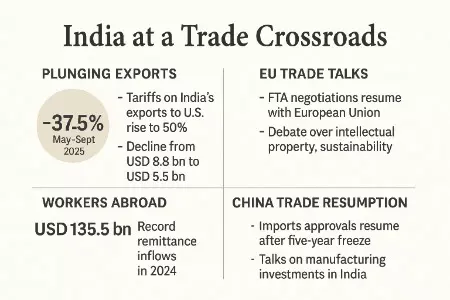Fragile Balancing of Markets
India’s trade diplomacy stands at an inflexion point — squeezed between America, Europe and China — where economic resilience and strategic foresight will determine the next decade’s balance of power

November begins with three major headlines, linked to India’s foreign trade, which are likely to enormously influence the Indian economy and its geostrategic alignment in the near future. India and the European Union on Monday (November 3) began discussions to resolve key outstanding issues in their proposed free trade agreement (FTA). India’s exports to the United States have witnessed a sharp and sustained fall, plunging 37.5 per cent between May and September 2025, following steep tariff hikes imposed by Washington. And on November 4, the Economic Times reported, India was set to resume approvals for Chinese imports after a five-year freeze.
India pays a 50 per cent tariff on its exports to the US, its largest market. The Trump tariffs began at 10 per cent, rose to 25 per cent on August 7, and reached 50 per cent by late August for India. According to a recent analysis by trade think tank Global Trade Research Initiative (GTRI), between May and September 2025, India saw its exports to the US plunge from USD 8.8 billion to USD 5.5 billion, which indicates a 37.5 per cent decline. Tariffs have not only squeezed India’s trade margins but also exposed structural vulnerabilities across key export industries,” GTRI observed.
This structural vulnerability cannot be overcome without proper innovation and technological competence, which India badly lacks due to chronic negligence in technological upgradation through research. Though the much hyped comprehensive Indo-US Free Trade Agreement (FTA) is not yet finalised and the Indian Prime Minister skipped the last ASEAN Summit to avoid meeting the US President, the White House spokeswoman told reporters (on November 3) that the US President has great respect for the Prime Minister and ‘they speak pretty frequently’. Unless the tariff issue with the USA is amicably sorted, Indian exports to the USA will drastically decline. The USA needs India for its geo-strategic game plan in the Asia Pacific region. Moreover, US farmers badly need the large Indian market to export their subsidised grains and soybeans. By skipping the ASEAN Summit, the Indian Prime Minister has missed an opportunity to strengthen India’s relationship with other major economies of the Asia Pacific region.
Commenting on the current EU-India FTA negotiation, the Indian commerce and industry ministry said that the focus would be on core areas such as trade in goods, services, rules of origin, and technical and institutional matters. The major roadblocks in the ongoing trade negotiation relate to the EU’s demand for stricter intellectual property rights (IPR) provisions (TRIPS PLUS) in the deal, which could go beyond the World Trade Organisation’s (WTO) TRIPS Agreement. India is resisting many of these demands, particularly those that might affect the affordability of generic medicines. Other key areas of negotiation include trade in goods, services, agriculture, and sustainability.
It may be recalled that in a letter, sent to the Union minister for commerce and industry Piyush Goyal, in May this year, patient groups, health organisations and patent experts have sought the Union government to reject any demands that required amendments to Indian Intellectual Property (IP) and regulatory laws, among other steps, during the negotiations for entering into Free Trade Agreements (FTA) with United States (US), United Kingdom (UK), and European Union (EU). They also requested the Ministry to reject any demands to introduce trade secret protection or data exclusivity provisions, as they go beyond international trade obligations. The letter sought the Ministry to follow strategies including “Actively protect and defend TRIPS flexibilities to ensure that India retains its full policy space to promote public health, protect self-reliant domestic pharma industry and secure access to affordable medicines.”
Export to the European Union is not easy. In addition to TRIPS Plus regulation, strict environmental and labour standards act as a serious non-tariff barrier. The EU’s Corporate Sustainability Due Diligence Directive (CSDDD) creates compliance demands that stretch far beyond Europe. The CSDDD introduces legal obligations for companies to identify and manage human rights and environmental risks across their supply chains – including those outside the EU. At the same time, the law requires the creation of climate transition plans that align with the Paris Agreement, including commitments toward limiting global warming to 1.5°C. The rules also carry financial risks. The EU plans to fine companies up to 5 per cent of their global turnover for violations. Under such a strict regulatory environment, Indian firms will find it increasingly difficult to remain competitive in the EU market.
Despite a huge deficit in merchandise trade, the foreign exchange position looks good due to increased inflows of remittances from Indian workers. Last year, the Indian diaspora sent home USD 135.46 billion. In 2016-17, inward remittance was USD 61 billion. India has been the world’s largest recipient of remittances for over a decade. Remittance significantly supports the country’s economy by covering nearly half (47 per cent) of its merchandise trade deficit. The increase is largely attributed to an expanding skilled workforce in countries like the US, UK, and Canada, which have higher wage prospects compared to the Gulf Cooperation Council (GCC) countries. But this year, due to visa restrictions in the USA, remittance flow from that country is likely to fall.
As per the New York Times, now India’s most valuable export is tens of millions of workers. New Delhi has quietly signed labour mobility agreements with at least 20 countries over the past half-dozen years — in Europe and Asia, including the Persian Gulf. In August, the countries started a program that could send 50,000 workers a year. It is reported that on October 9, India’s foreign ministry announced a draft legislation for an Overseas Mobility Bill to replace the Emigration Act of 1983. The text proposes to help Indian citizens connect with the “global workplace,” paying special attention to ensuring workers’ “safe and orderly return, and reintegration of returnees.” Over 20,000 Indian nationals are currently employed in Israel, including 6,774 who entered the country under the India-Israel bilateral framework agreement as of July 1, 2025.
It appears that Indian workers have substantial demand in the developed economies. Instead of encouraging overseas migration, Indian policymakers must explore possibilities of engaging millions of skilled Indian workers in the domestic sector. As relations with China have improved, India should insist that China establish factories in India for supplying products that India imports from them. Chinese President Xi Jinping highlighted the importance of the Panchsheel agreement during his meeting with Indian Prime Minister Narendra Modi on the sidelines of the recent SCO summit in Tianjin, China. Panchsheel, or the five principles of peaceful co-existence, were first formally termed in the Agreement between the Tibet region of China and India, signed in 1954. The five pillars of the principle include: Respect for each other’s territorial integrity and sovereignty, Non-aggression, Non-interference, Equality and mutual benefit, Peaceful co-existence. As China is the largest source of India’s imports, and is experiencing a rapid decline in birth rates, it will be a win-win situation for both countries if India can attract Chinese investments in the manufacturing sector and engage Indian workers instead of exporting them to foreign countries.
Views expressed are personal. The writer is a professor of Business Administration who primarily writes on political economy, global trade, and sustainable development



